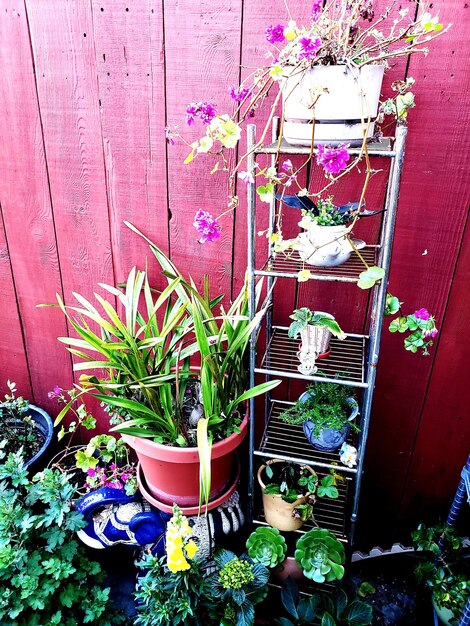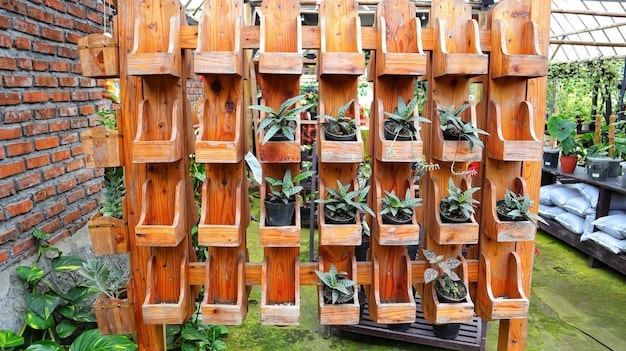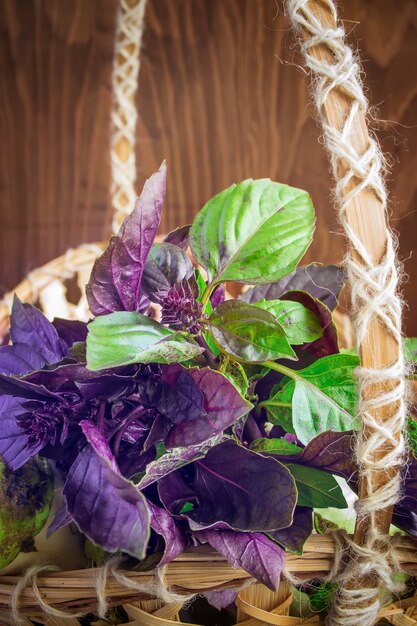Vertical Garden Ideas: Small Space Herb & Veggie Paradise

Creating a vertical garden for small spaces allows you to grow fresh herbs and vegetables year-round by maximizing limited areas, such as balconies or patios, with innovative and space-saving gardening techniques.
Dreaming of fresh herbs and veggies but short on space? Discover how to create a vertical garden for small spaces, grow fresh herbs and vegetables year-round, even with limited room, and enjoy a thriving garden that’s both beautiful and practical.
Why Choose a Vertical Garden for Small Spaces?
Vertical gardens are the perfect solution for urban dwellers and anyone with limited gardening space. They offer a multitude of benefits, transforming small areas into thriving green spaces. Instead of spreading out horizontally, vertical gardens utilize vertical surfaces, making them ideal for balconies, patios, and even indoor spaces.
But what makes vertical gardening so appealing? Let’s delve into the advantages it offers.
Space Efficiency
Perhaps the most significant advantage is space efficiency. Vertical gardens allow you to grow a surprising amount of plants in a small footprint. By using walls, fences, and stacked planters, you can maximize your growing area without sacrificing precious square footage.
Improved Air Quality
Plants naturally purify the air, and a vertical garden can significantly improve air quality in your home or outdoor space. They absorb pollutants and release oxygen, creating a healthier and more pleasant environment.
Aesthetic Appeal
Beyond their practical benefits, vertical gardens add beauty and visual interest to any space. A lush green wall can transform a drab balcony into a vibrant oasis, enhancing the overall aesthetic appeal of your home.
- Maximizes space in urban environments.
- Enhances air quality by filtering pollutants.
- Adds a visually appealing element to your home.
- Provides easy access to fresh herbs and vegetables.
In conclusion, vertical gardens are a versatile and attractive solution for small-space gardening. They offer numerous benefits, from space efficiency to improved air quality, making them a worthwhile investment for any home.
Choosing the Right Location and Structure
Before diving into planting, it’s crucial to select the right location and structure for your vertical garden. The success of your garden depends on factors like sunlight, accessibility, and the type of plants you want to grow.
Here’s how to make the best choices for your space.

Sunlight Considerations
Most herbs and vegetables require at least six hours of sunlight per day. Observe your chosen location throughout the day to determine how much direct sunlight it receives. If sunlight is limited, consider using grow lights to supplement natural light.
Structural Options
There are various structural options for vertical gardens, each with its own advantages. Consider the space you have available, your budget, and your personal style when making your selection. Options include:
- Wall-mounted planters: These are attached directly to a wall or fence, offering a clean and organized look.
- Stacked planters: These tiered planters save space and allow for a variety of plants.
- Hanging baskets: Ideal for herbs and trailing vegetables, hanging baskets add a touch of charm to your garden.
- DIY structures: Get creative and build your own vertical garden using reclaimed materials like pallets or wooden crates.
Accessibility
Ensure your vertical garden is easily accessible for watering, pruning, and harvesting. Consider the height of your structure and whether you can comfortably reach all the plants.
Choosing the right location and structure is crucial for the success of your vertical garden. By considering sunlight, structural options, and accessibility, you can create a thriving and easily maintainable green space.
Selecting the Best Herbs and Vegetables
Choosing the right plants is essential for a successful and productive vertical garden. Not all herbs and vegetables thrive in vertical systems, so it’s important to select varieties that are well-suited to container gardening and vertical growth.
Here’s a guide to some of the best options.
Herbs
Herbs are a natural fit for vertical gardens. They are generally compact, easy to grow, and offer a wide variety of flavors and aromas. Some excellent choices include:
- Basil: A culinary staple, basil thrives in warm sunny conditions.
- Mint: Easy to grow and incredibly versatile, mint is perfect for teas, cocktails, and culinary dishes.
- Chives: With their mild onion flavor, chives are a great addition to salads, soups, and dips.
- Parsley: This versatile herb is a must-have in any kitchen garden.
Vegetables
While not all vegetables are suitable for vertical gardens, there are several that do exceptionally well. Opt for compact varieties and those that don’t require extensive root systems, such as:
- Lettuce: Loose-leaf lettuce varieties are easy to grow and can be harvested repeatedly.
- Spinach: A nutritious and easy-to-grow leafy green.
- Strawberries: These sweet berries thrive in hanging baskets and vertical planters.
- Peppers: Compact pepper varieties like chili peppers and bell peppers do well in containers.

Consider the Season
Choose herbs and vegetables that are appropriate for the current season. Cool-season crops like lettuce and spinach thrive in spring and fall, while warm-season crops like basil and peppers prefer the summer months.
Selecting the best herbs and vegetables for your vertical garden is not just about choosing what you like to eat. It’s about creating a system where plants thrive together, maximize space, and provide a continuous harvest. Consider starting with a few easy-to-grow varieties and expanding your selection as you gain experience.
Setting Up Your Vertical Garden
Now that you’ve chosen your location, structure, and plants, it’s time to set up your vertical garden. This involves preparing your containers, planting your herbs and vegetables, and ensuring proper watering and drainage.
Here’s a step-by-step guide to get you started.
Preparing Your Containers
Whether you’re using wall-mounted planters, stacked planters, or hanging baskets, ensure your containers have adequate drainage holes. Line the bottom of each container with landscape fabric to prevent soil from washing out.
Choosing the Right Soil
Use a high-quality potting mix that is lightweight and well-draining. Avoid using garden soil, as it can become compacted in containers and restrict root growth.
Planting Your Herbs and Vegetables
Gently remove your herbs and vegetables from their nursery pots and loosen the root ball. Plant them in your prepared containers, spacing them according to their mature size. Water thoroughly after planting.
Watering and Drainage
Proper watering and drainage are critical for the success of your vertical garden. Water your plants regularly, but avoid overwatering, which can lead to root rot. Ensure excess water can drain away from the containers.
Fertilizing Your Garden
Vertical gardens often require more frequent fertilization than traditional gardens, as nutrients can leach out of the containers over time. Use a balanced liquid fertilizer every few weeks to promote healthy growth.
Setting up your vertical garden is a rewarding process that brings you closer to enjoying fresh, homegrown produce. With the right preparation and attention to detail, you can create a thriving garden that provides you with herbs and vegetables year-round.
Maintenance and Care Tips
Maintaining a vertical garden requires regular attention to ensure your plants thrive. Simple steps like watering, pruning, and pest control can significantly impact the health and productivity of your garden.
Here are some essential maintenance and care tips.
Regular Watering
Check the soil moisture levels daily and water your plants when the top inch of soil feels dry. Adjust your watering schedule based on weather conditions and the needs of your plants. During hot, dry periods, you may need to water more frequently.
Pruning and Harvesting
Prune your herbs and vegetables regularly to encourage bushy growth and prevent them from becoming leggy. Harvest your produce as it ripens to encourage continued production.
Pest and Disease Control
Inspect your plants regularly for signs of pests or diseases. Address any issues promptly to prevent them from spreading. Use organic pest control methods like insecticidal soap or neem oil to keep your garden healthy.
Nutrient Management
Keep an eye out for signs of nutrient deficiencies, such as yellowing leaves or stunted growth. Supplement with liquid fertilizer to ensure plants receive adequate essentials.
- Regularly check soil moisture and adjust watering as needed.
- Prune herbs and vegetables to encourage growth.
- Inspect plants for pests and diseases and treat promptly.
- Provide balanced fertilization.
Maintenance and care are the ongoing commitments that transform a vertical garden from a simple project into a sustainable source of fresh produce. Regular care can transform vertical gardens into a thriving and productive ecosystem.
Troubleshooting Common Issues
Even with the best care, you may encounter some common issues in your vertical garden. Recognizing these problems early and knowing how to address them can help you keep your garden healthy and productive.
Here are some common issues and their solutions.
Yellowing Leaves
Yellowing leaves can indicate overwatering, nutrient deficiencies, or pest infestations. Check the soil moisture and adjust your watering schedule. Fertilize with a balanced liquid fertilizer to address nutrient deficiencies. Inspect your plants for pests and treat accordingly.
Stunted Growth
Stunted growth can be caused by a lack of sunlight, poor soil, or root-bound plants. Ensure your garden receives adequate sunlight. Repot your plants into larger containers with fresh potting mix if they are root-bound.
Pest Infestations
Pest infestations can quickly decimate a vertical garden. Common pests include aphids, spider mites, and whiteflies. Use organic pest control methods like insecticidal soap or neem oil to eliminate pests.
Disease Problems
Disease problems such as powdery mildew or fungal infections can affect the health of your plants. Ensure good air circulation around your plants and avoid overhead watering. Treat affected plants with a fungicide.
Troubleshooting common issues in your vertical garden is about being proactive and attentive. Regular observation, quick action, and a little bit of knowledge can help you overcome problems and maintain a beautiful and productive vertical garden year-round.
| Key Point | Brief Description |
|---|---|
| 🌱 Space Saving | Maximizes small areas for growing herbs and vegetables. |
| ☀️ Light is Key | Ensuring plants get 6+ hours of sunlight daily is essential. |
| 🌿 Herb Choices | Basil, mint, and chives are perfect for vertical setups. |
| 💧 Watering | Check soil daily; adjust based on weather & plant needs. |
Frequently Asked Questions
▼
Great choices include herbs like basil, mint, and chives, as well as vegetables like lettuce, strawberries, and compact pepper varieties. These plants thrive in containers and vertical systems.
▼
Most herbs and vegetables require at least six hours of sunlight per day. If you don’t have enough natural light, consider supplementing with grow lights to ensure healthy growth.
▼
Use a high-quality, lightweight potting mix that drains well. Avoid using garden soil, as it can become compacted in containers and restrict the growth of plant roots.
▼
Check the soil moisture daily and water your plants when the top inch feels dry. Adjust your watering schedule based on weather conditions and the needs of your plants.
▼
Inspect your plants regularly for signs of pests or diseases. Use organic pest control methods like insecticidal soap or neem oil to keep your garden healthy and thriving.
Conclusion
Creating a vertical garden for small spaces is an innovative and rewarding way to grow fresh herbs and vegetables year-round. By choosing the right plants, structure, and location, and with consistent maintenance, you can enjoy a vibrant and productive garden no matter how limited your space. Embrace the possibilities of vertical gardening and transform your small area into a green oasis.




